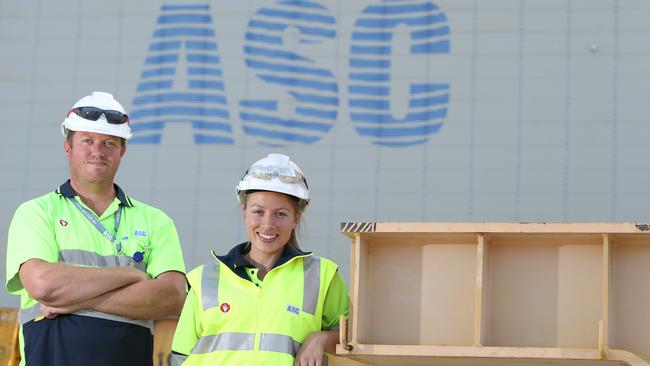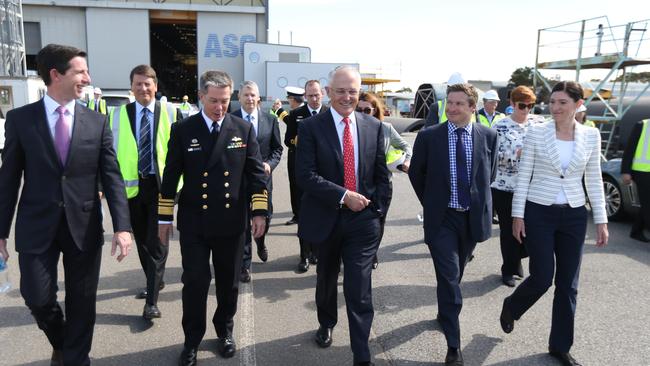Jubilant South Australia celebrates submarine win at Osborne
A JUBILANT South Australia will reap an economic and jobs bonanza from the nation’s next generation of 12 submarines to be built in Adelaide with French shipbuilders DCNS.
SA News
Don't miss out on the headlines from SA News. Followed categories will be added to My News.
- $50bn Future Submarines to be built in Adelaide by French firm DCNS
- Weatherill says decision to build 12 submarines in Adelaide will kickstart jobs ‘immediately’
- Japan asks for explanation on submarine contract going to France’s DCNS
- How the French Barracuda differs from the Collins class sub
A JUBILANT South Australia will reap an economic and jobs bonanza from the nation’s next generation of 12 submarines to be built in Adelaide with French shipbuilders DCNS.
After more than a year of deliberations, Prime Minister Malcolm Turnbull announced yesterday the $50 billion Future Submarines project had been awarded to DCNS because the capability of their proposed Shortfin Barracuda submarine outstripped that of its competitors.
He earlier obtained the approval of Federal Cabinet for the project, which will result in an estimated 2800 jobs being created — 1700 of them at ASC in Osborne. Mr Turnbull declared the boats would be “the most sophisticated naval vessels being built in the world” and that they would be built with Australian steel, although more investment would be needed to produce the right steel to make hulls.
Premier Jay Weatherill said it was “the most improbable victory” that paved the way for a world-class advanced manufacturing sector in SA.
“This is a massive step forward in the transformation of the SA economy, to meet our vision for an advanced manufacturing (and) hi-tech manufacturing economy,” he said.
Mr Turnbull said the spin-offs into the rest of the economy would be “immense”.
“We have the technology and the skills and the advanced manufacturing and the jobs for our children and our grandchildren for decades to come, because we know that ... the submarine project alone will generate an additional 2800 Australian jobs,” he said.
“These submarines will be the most sophisticated naval vessels being built in the world. And they will be built here in Australia, with Australian jobs, Australian steel, Australian expertise and ... our successful transition to the economy of the 21st century.”

On Monday night, Mr Turnbull called French president Francois Hollande to inform him that the French company had won the giant contract. Mr Hollande welcomed the “historic choice”; a choice that will also “mobilise” 4000 jobs and pump $11.7 billion into the economy. France will still be in charge of building some parts, such as the subs’ “nose” and some parts of the pressure hull.
Labor originally proposed 12 submarines to be built in SA in the 2009 Defence White Paper but did not make progress before the Coalition — who made the same pledge for 12 homegrown boats while in Opposition — defeated them in 2013. However, the Abbott Government then backed away from the promise and seemed set to buy just eight submarines built in Japan.
Public and political pressure and expert opinion, coupled with the Coalition’s fear of losing SA seats, helped turn that situation around. Japan has now been left sorely disappointed by the decision and defence minister Gen Nakatani said it would ask the reasons Australia chose another design. However, Mr Turnbull sought to ease any fallout, saying Australia’s “special relationship” with Japan “gets stronger day by day”.
German shipbuilders ThyssenKrupp Marine Systems said they respected the decision but would be willing to help in other ways. “We are naturally disappointed,” the company’s Australian chairman, John White, said.
There were lingering concerns over Japan’s ability to export its technology, while some thought Germany would struggle to double the size of its existing submarine to meet Australian requirements.

Mr Turnbull said France was the “absolutely unambiguous recommendation from the Department of Defence” after the 15-month competitive evaluation process. DCNS Australia chief executive Sean Costello said it was “not a champagne moment” for his team.
“It’s a moment for silent reflection. We’re very much focused on the responsibilities that have been laid on us,” he said. Work now begins on more detailed designs, the development of facilities — and the all-important supply chain and transfer of technology.
Defence Minister Marise Payne said the navy needed quiet submarines that could detect other submarines; that could travel long distances and stay “undisturbed and undetected”. After emphasising the strategic importance of the submarines, she said that this project, along with the nine Future Frigates and the 12 Offshore Patrol Vessels, made it “an exciting time to be a South Australian”.
“Adelaide will be at the heart of all major naval shipbuilding acquisitions beginning right now and for many decades to come,” she writes. Industry Minister Christopher Pyne — whose seat of Sturt may well have been secured by the deal — agreed, saying: “This of course means a continuous naval ship building industry for decades into the future which all first world countries should aspire to.”
As Australia heads to the polls on July 2, Labor welcomed the announcement but claimed credit along with the SA community for bringing the Government “kicking and screaming” to the decision.
It said the contract had yet to be signed and Opposition Leader Bill Shorten added “the devil will be in the detail”. But Mr Turnbull said the deal would likely be inked later this year and the design process would take about seven years.
Speaking later to The Advertiser, Mr Turnbull attempted to minimise Senator Nick Xenophon’s role in securing the submarine program — pointedly without naming him — and accused Labor of leading Osborne workers into a jobs “valley of death”.
“An independent member, no matter how committed, simply doesn’t have the capacity to deliver very much,” he said. The PM said major maintenance work would also be done at Osborne, as with the Collins Class.


